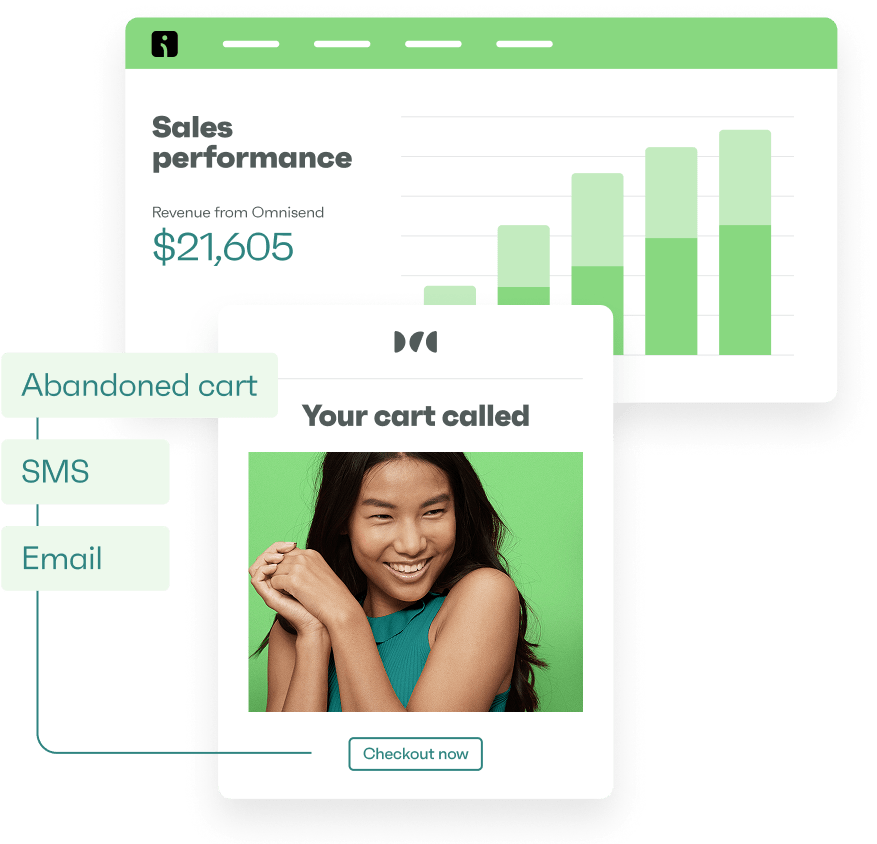Drive sales on autopilot with ecommerce-focused features
See FeaturesBlack Friday consumer segmentation is an effective way to get the most out of your email list and generate massive revenue during the holidays and post-holiday season. Instead of blasting the same offer to everyone, group shoppers based on their behavior to connect and understand what customers really need.
Smart segmentation means using simple, first-party data to group shoppers to send the right message to the right person. Your VIP customers get early access, price-sensitive shoppers see your best deals, and cart abandoners receive gentle nudges with dynamic product images.
This results in higher open rates, better conversions, and more revenue per email. Black Friday customer segmentation also protects your sender reputation because messages match what your audience wants to see.
Here, you’ll learn how to gather the right data, build segments that matter, and time your campaigns for maximum impact. We’ll cover 10 high-performing segments, along with the best channels and timing strategies to achieve success on Black Friday.
Quick sign up | No credit card required
What is Black Friday customer segmentation?
Black Friday customer segmentation involves grouping shoppers by their behaviors and values.
You look at what they’ve bought, when they engage, and how much they spend. Then, based on this customer data, you create targeted groups instead of blasting one message to everyone during BFCM.
Your Black Friday consumer segmentation strategy relies on data from your store, such as:
- Purchase history
- Email engagement
- Browse behavior
- Cart activity
The main benefits come from using data for accuracy. When you segment by orders and RFM data (recency, frequency, monetary value), you identify purchasing patterns that predict future behavior.
AOV and CLV metrics reveal which customers drive the most revenue, while categories browsed and carts started show immediate purchase intent.
You’ll see an improvement in your email marketing ROI when engagement recency data helps you target active subscribers rather than dormant ones.
Also, geography and consent status for email and SMS channels ensure you’re reaching the right people through their preferred communication methods during peak shopping periods.
This Omnisend video walks through the complete process of building a Black Friday consumer segmentation strategy effectively. You’ll learn exactly how to set up each segment type and what data points matter most:
How to build your own Black Friday segments
Building effective Black Friday customer segmentation requires three key steps that work together:
1. Gather the data
Effective Black Friday customer segmentation relies on collecting data before BFCM arrives. This will give you enough time to analyze patterns. Start gathering information at least a couple of weeks before Black Friday.
Focus on these essential data points:
- Orders and RFM data (recency, frequency, monetary value)
- Average order value and customer lifetime value
- Product and category purchase history
- Coupon and discount usage patterns
- Browse and cart events from your website
- Email engagement recency (opens and clicks)
- Geographic location and time zone information
Remember that segments update quickly during peak shopping days. Set your data to refresh every few hours during Black Friday week for accurate and real-time targeting.
2. Set objectives
Define specific outcomes you want from each segment before you start building Black Friday consumer segmentation campaigns. For example, you might want cart abandoners to complete checkout or increase the average order value of existing customers.
Your success metrics should align with these goals. For instance, you should track revenue per recipient to see which segments generate the most value or monitor conversion rates to identify your most responsive audiences.
3. Turn data into rules
Convert your data into practical segment rules for simpler Black Friday customer segmentation. These examples show how raw data becomes actionable segments:
- “Top 10% by revenue in the last 365 days” identifies your highest-value customers
- “Added to cart in the last 14 days with no purchase” targets recent cart abandoners
- “Coupon used in 50% or more of historical orders” finds your price-sensitive shoppers
Include exclusion rules to keep your messaging relevant, such as excluding recent purchasers from broad promotional campaigns for a few days after they buy.
Ultimately, customer lifecycle segmentation is the foundation for your BFCM marketing campaigns. It separates customers based on their relationship with your brand.
Use the segments
Once you’ve built your segments, tailor your message to match each specific segment.
VIP customers respond to exclusivity, while price-sensitive shoppers need clear value propositions.
Always skip people who have just bought, as recent purchasers don’t need discount offers on items they already own.
Omnisend’s segmentation feature makes this process straightforward:
- Navigate to Audiences in your Omnisend dashboard
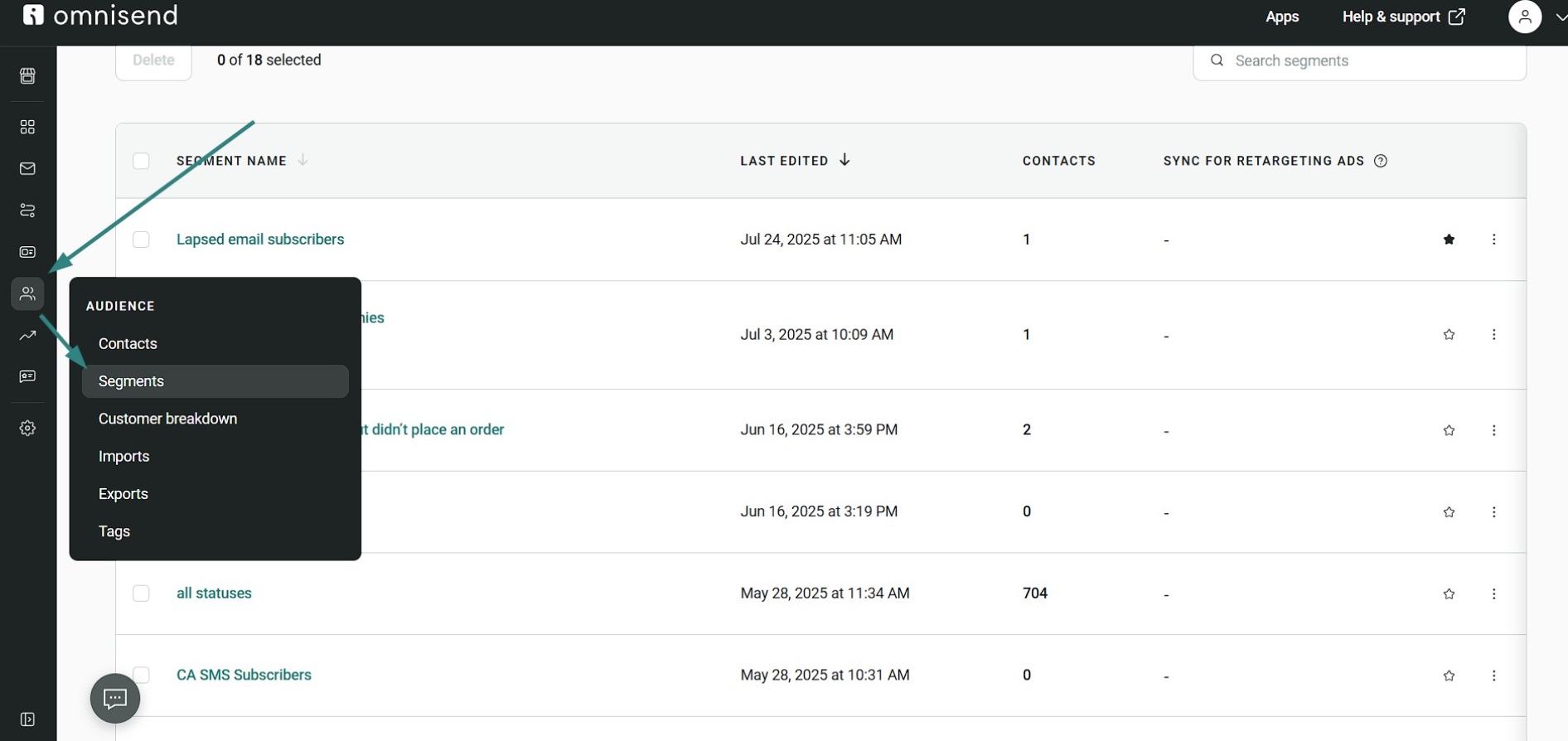
- Click Create segment and choose your data criteria
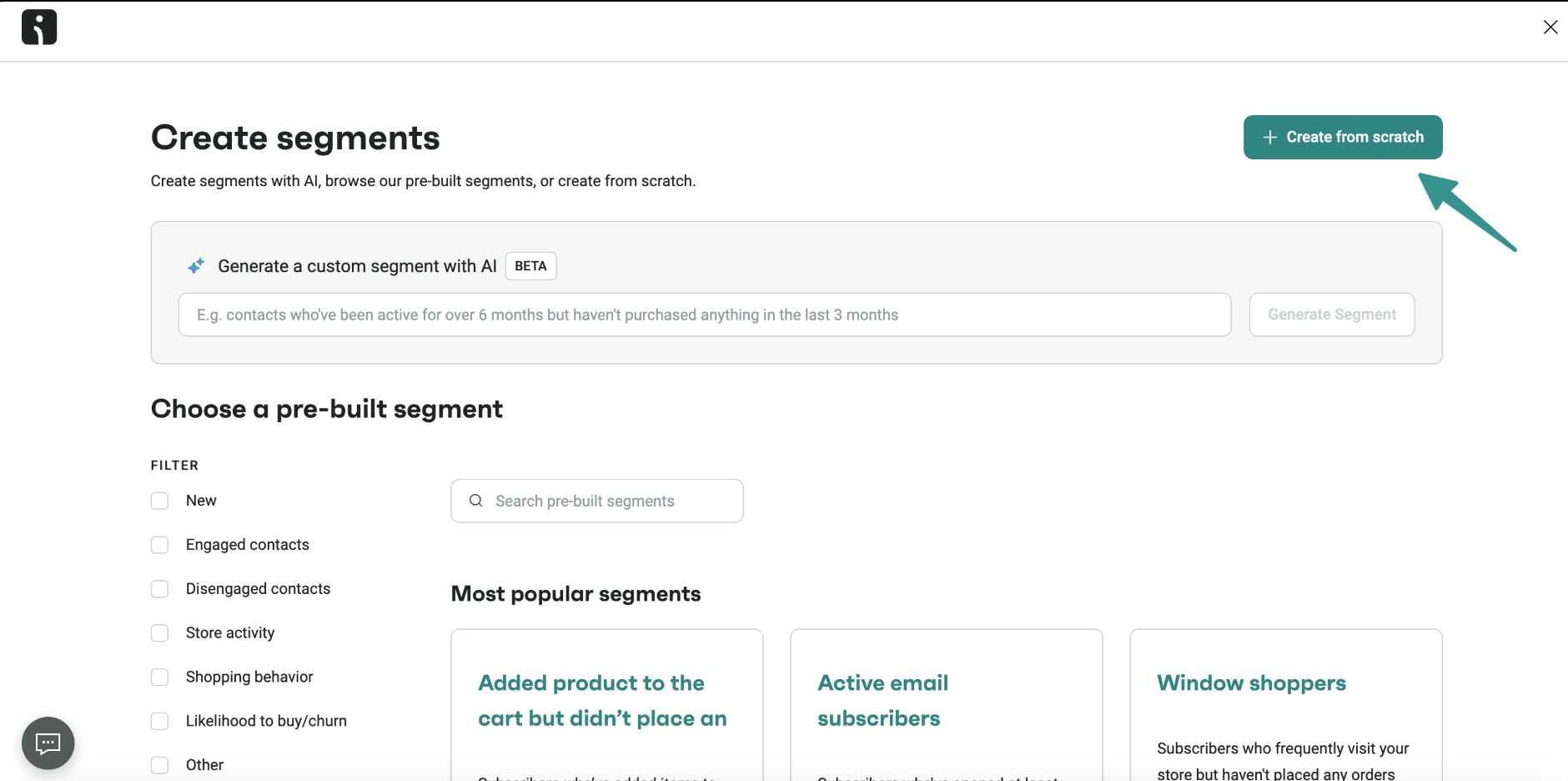
- Add multiple conditions using AND or OR logic
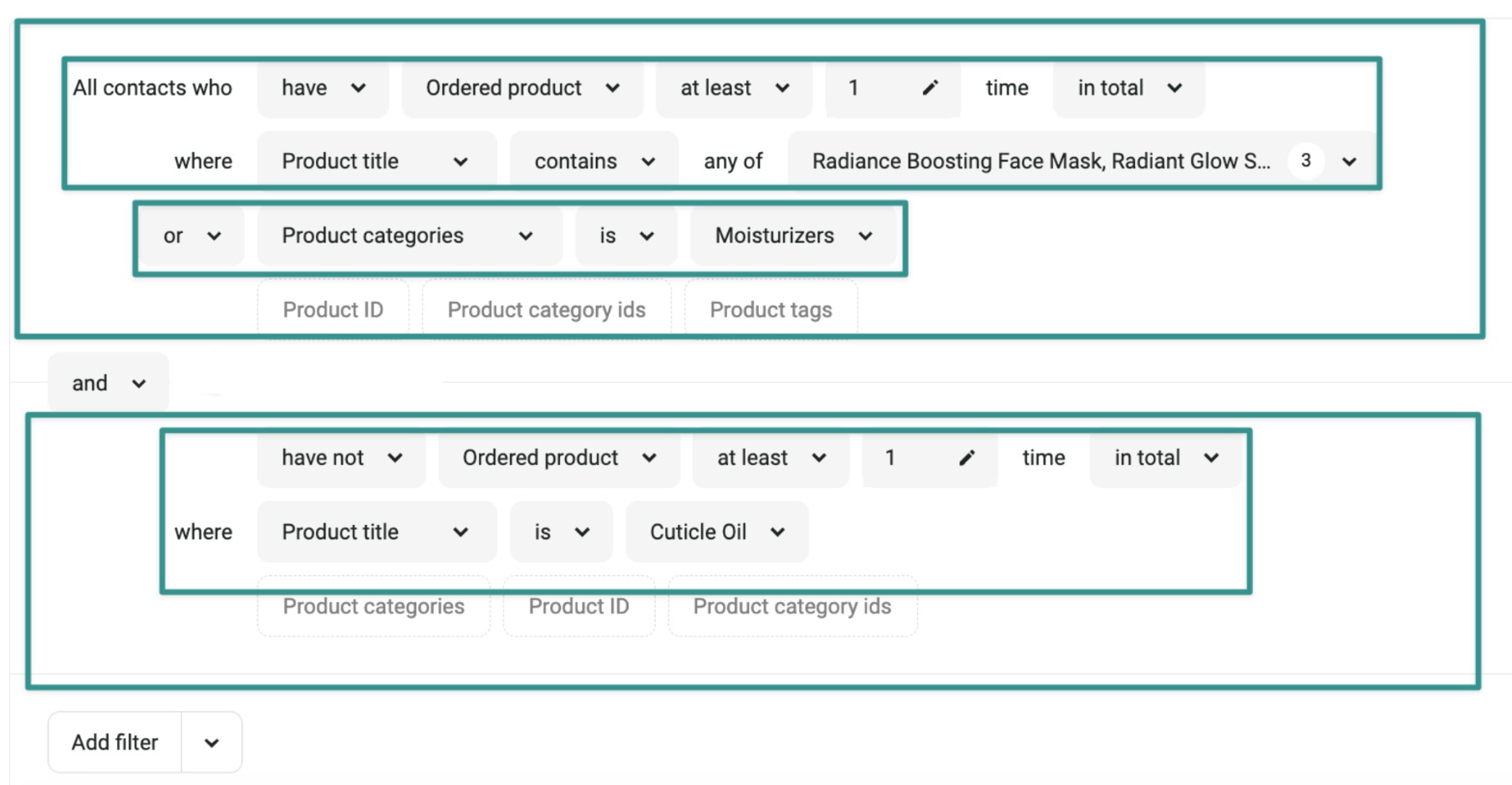
- Preview your segment size and save with a descriptive name
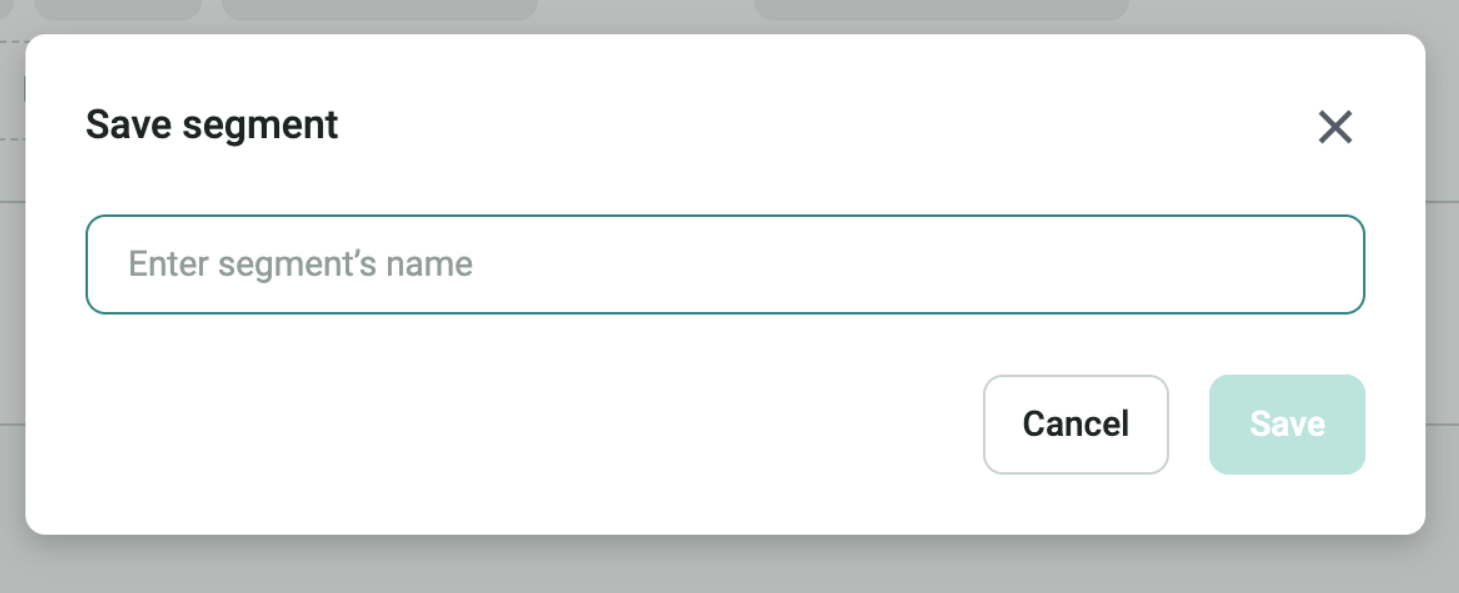
- Select your saved segment when creating any email campaign
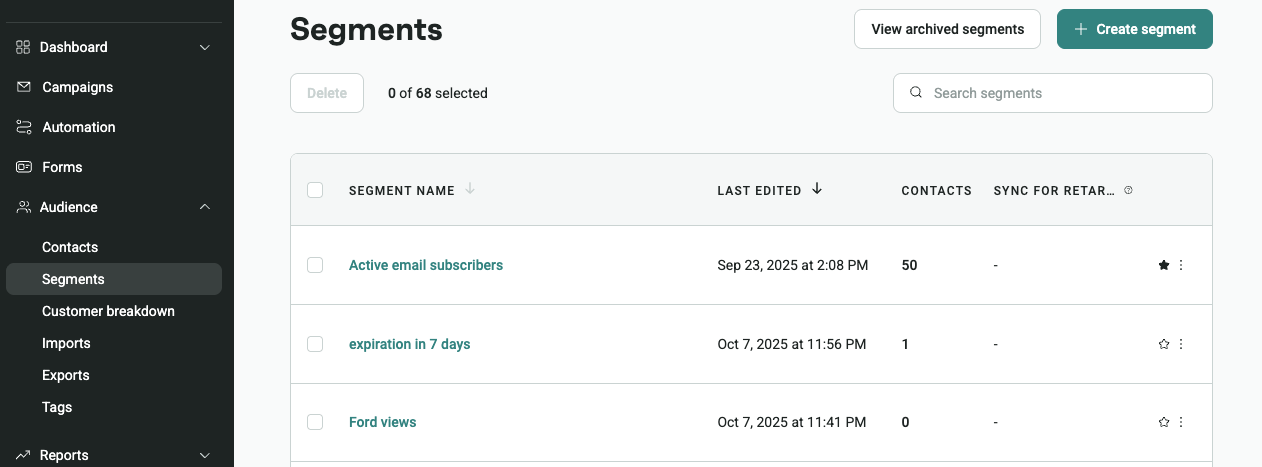
10 high-impact Black Friday customer segments
These Black Friday customer segmentation groupings deliver the best results. They target customers based on proven buying behaviors and engagement patterns.
1. Highest-value customers
Identify customers in the top five to 10 percent by lifetime value or with over three orders in the past year. These high-value shoppers drive the most revenue per email and deserve premium treatment in Black Friday consumer segmentation.
Prioritize exclusivity over discounts like early access, priority shipping, or members-only bundles.
Exclude them from generic promos to protect VIP status, and add a post-purchase cool-off period to prevent overselling.
2. Cart abandoners
These shoppers recently added items to their cart but didn’t complete checkout within your typical purchase window. They’ve shown clear buying intent, so they’re prime candidates for Black Friday marketing strategies that remove friction.
Your messaging should confirm intent and remove barriers. Include dynamic product images of their exact cart items, clarify shipping cutoff dates, and add trust signals like return policies or customer reviews.
Columbia’s cart abandonment email shows this perfectly. It features the exact product the customer viewed, reveals a price drop to create urgency, and includes related items to increase order value:
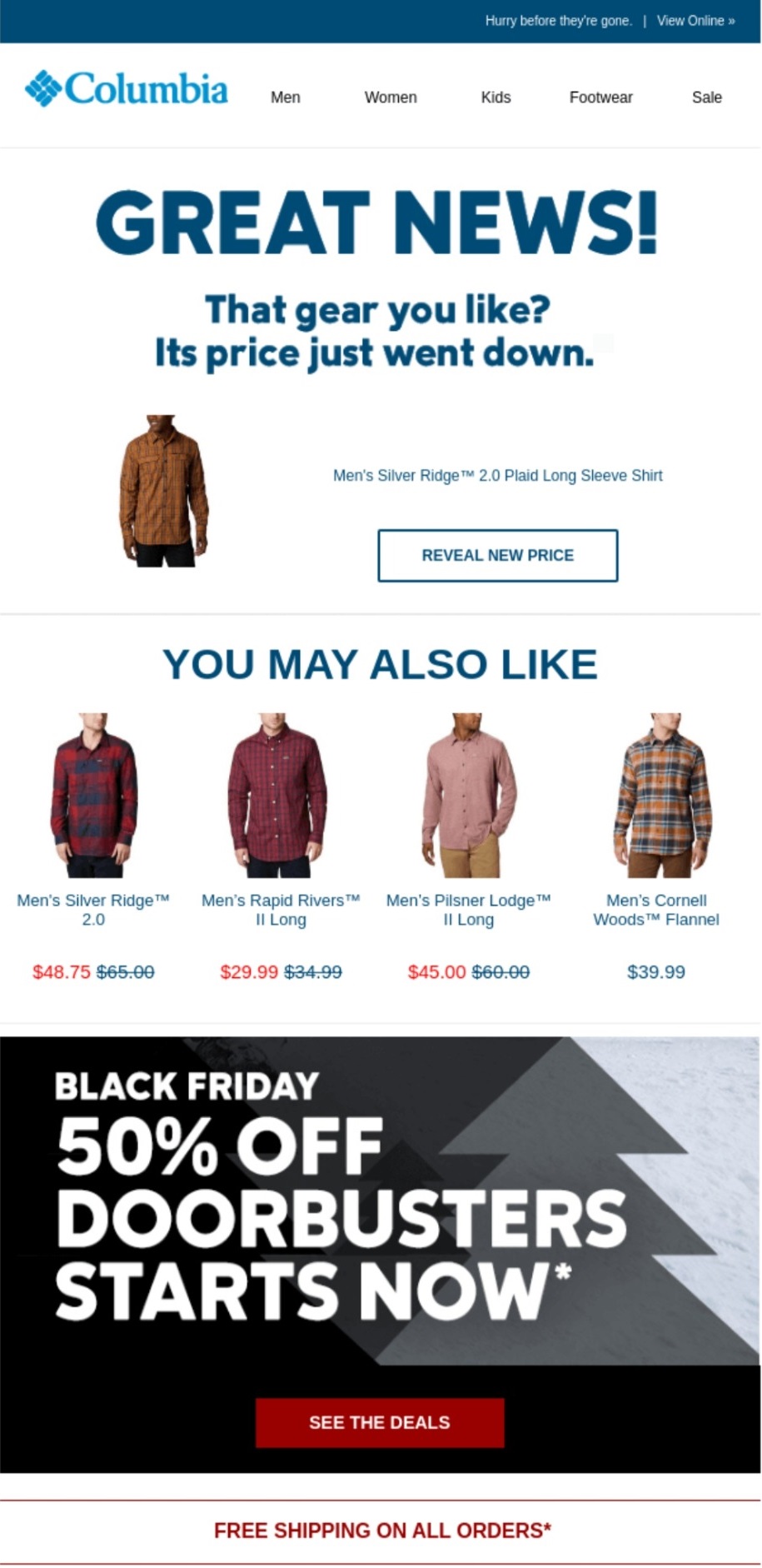
3. Black Friday one-time buyers
Target customers who made exactly one purchase during the previous year’s BFCM but never returned to your store. These shoppers proved they’ll buy from you during peak season but need reasons to come back.
Connect your messaging to their previous purchase category while highlighting what’s new. Include social proof and keep urgency messaging light since aggressive tactics might have scared them away.
Build trust by referencing their previous positive experience and showing how your brand has grown or improved.
4. Lapsing customers
This segment includes past buyers who have been inactive for three to six months or have been less engaged with emails. They have purchase history but need reactivation.
Personalize messages around their past categories and patterns, offering modest perks like free shipping or small discounts instead of broad promotions that risk cheapening your brand.
The School of Life’s approach works well here. It offers a thoughtful discount and emphasizes the meaningful nature of its products, not relying on aggressive sales tactics:
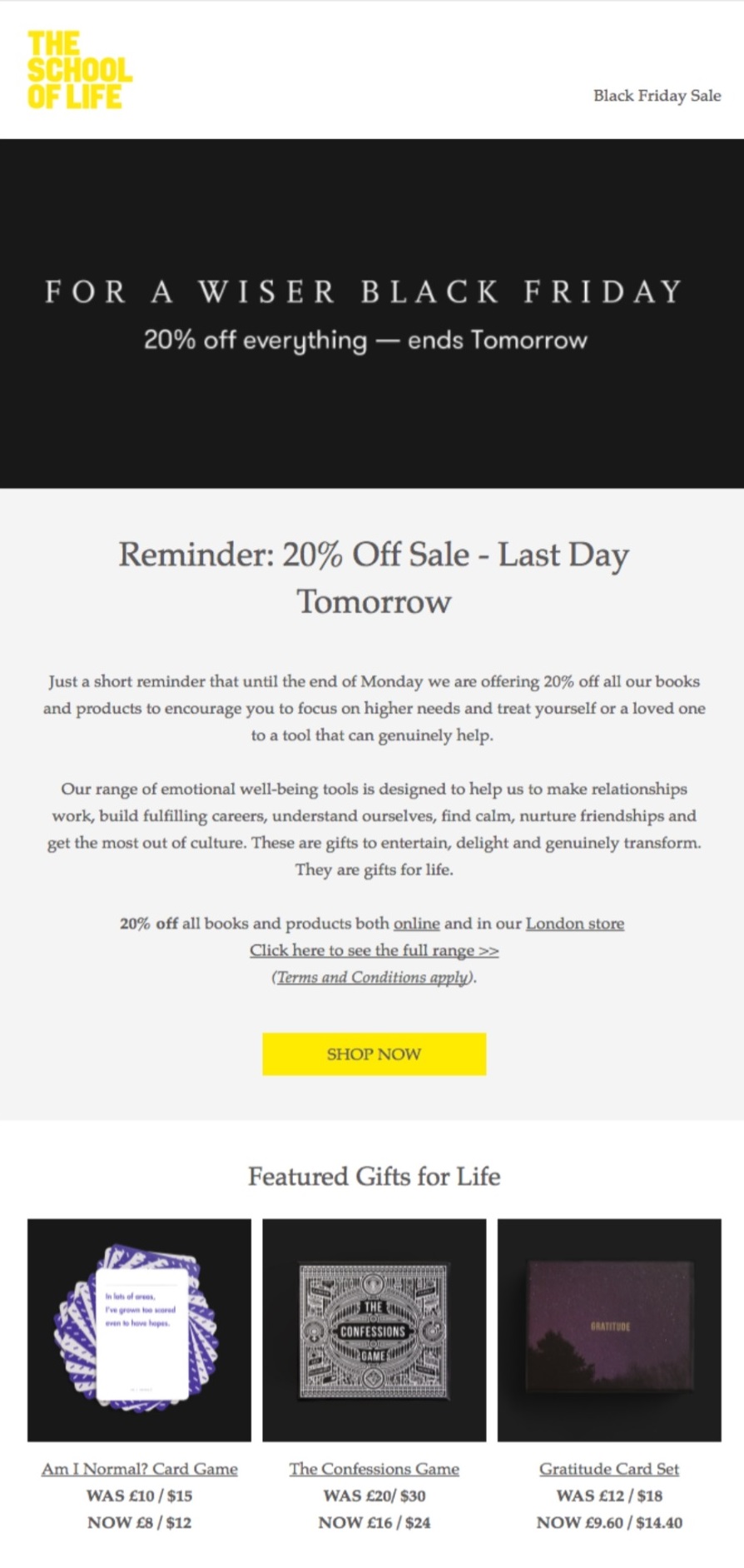
5. Recent purchasers
Here, it’ll be customers who bought within the last 30 days. These shoppers don’t need convincing, and they also don’t need discounts on items they just purchased.
Avoid buyer’s remorse by focusing on complementary products, accessories, or refills that enrich their recent purchase. Offer soft perks like extended return periods, free shipping upgrades, or gift wrapping services that add value without discounting.
6. Price-sensitive buyers
Identify customers who use coupons in more than 50% of past orders or mainly buy during promotions. These deal-driven shoppers can still add value with smart Black Friday consumer segmentation.
Use tiered offers or bundle deals tied to spend thresholds to raise order value while giving the discounts they expect.
Teep’s Black Friday announcement demonstrates this perfectly. It creates excitement around the “biggest sale of the year” while using tiered offers like “buy 1, get 40% off” that encourage larger purchases while protecting profit margins:
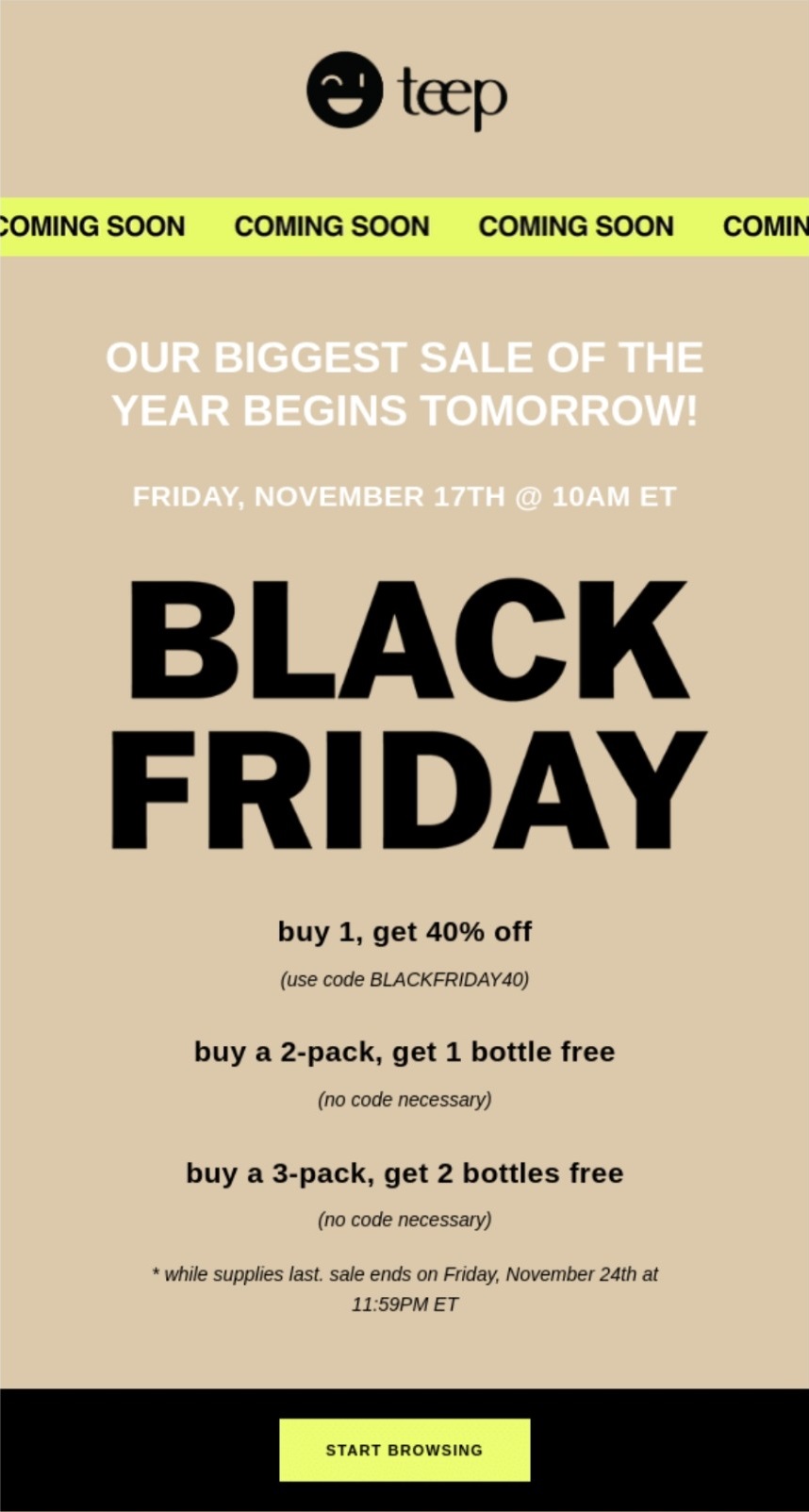
7. Loyal repeat purchasers
These customers make regular purchases without heavy discounting. They typically respond quickly to new product releases. They’ve proven their loyalty to your brand.
Highlight recognition and early access opportunities rather than training them to expect discounts. Offer members-only perks, sneak peeks at upcoming collections, or exclusive colorways that make them feel special without reducing margins.
8. Engaged non-buyers
This segment includes subscribers who clicked email links multiple times but haven’t purchased yet. They’re interested but need a nudge to convert.
Focus on clarity and trust — highlight bestsellers, add fit guides or usage tips, and showcase reviews that address common concerns.
Freaks of Nature handles this segment well by creating urgency around limited stock while providing clear product information and maintaining its brand personality. The “going, going, almost gone” messaging works without being pushy:
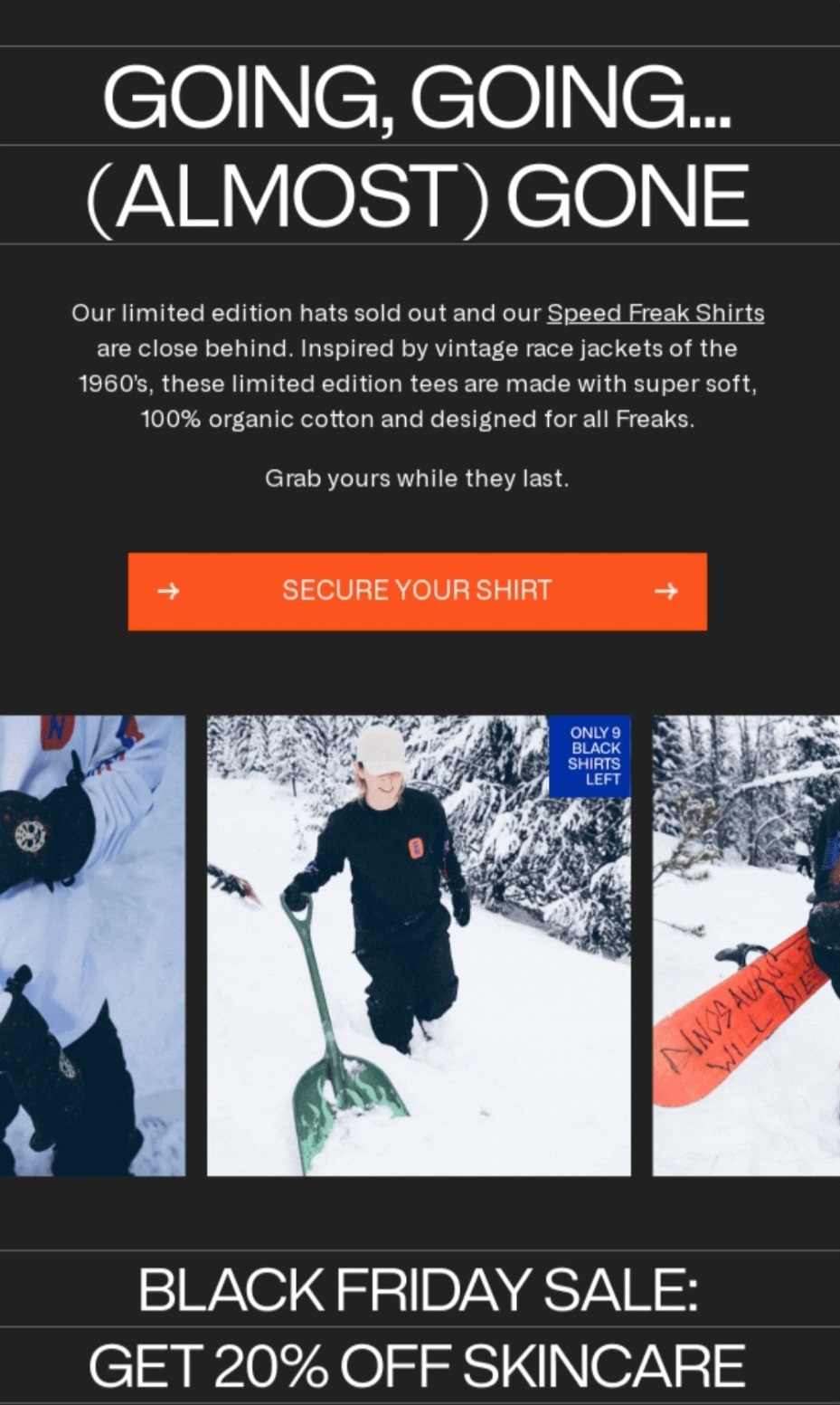
9. Category browsers
Target shoppers who viewed certain products or categories multiple times in the last 30 days.
Their browsing shows strong interest, so share category-specific content like comparisons, bundles, or sizing/fit details to address concerns.
Stop automated sequences after purchase and shift to cross-selling complementary items.
10. Regional customers
Location is important in Black Friday customer segmentation. Segment customers by geographic location to address regional preferences, shipping limitations, and cultural shopping behaviors.
Adjust your product focus based on regional preferences while localizing timing, currency display, and shipping cutoff dates.
Withings demonstrates regional targeting by creating bundles that appeal to health-conscious shoppers while timing its “don’t wait for Black Friday” message appropriately for its target market’s shopping patterns and preferences:
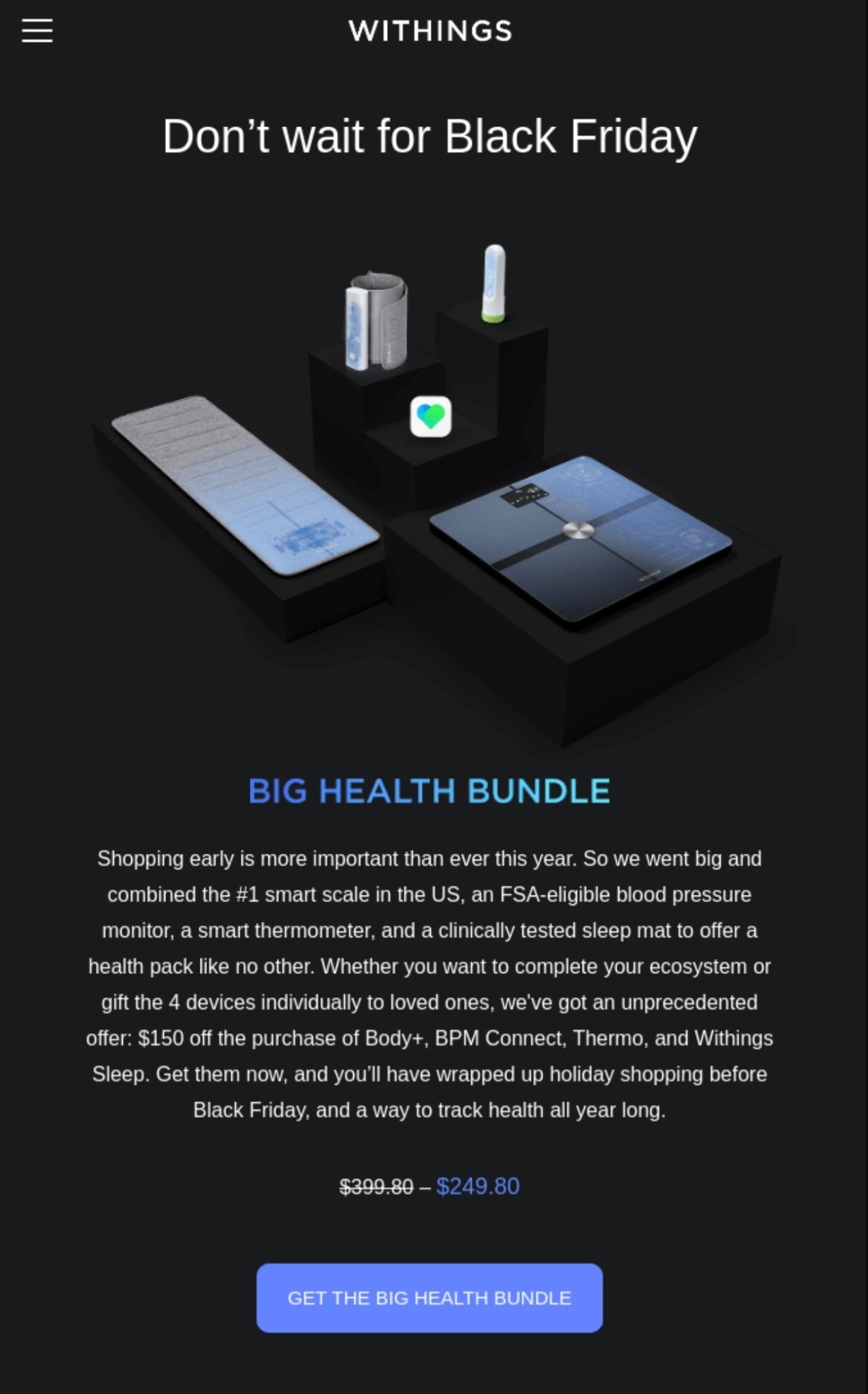
Channels for Black Friday segments
Your Black Friday consumer segmentation strategy works across multiple channels, with each serving different purposes and timing needs.
This channel allows you to target your saved segments with detailed product information and compelling visuals. The key is to align your email marketing content with the specific segment you’re targeting rather than sending generic promotions.
This includes tailoring Black Friday subject lines to each segment’s motivations and interests.
Also, add simple suppressions at send time to keep messaging relevant:
- Implement recent purchaser cool-offs to avoid overselling
- Remove undeliverable addresses to protect your sender reputation
- Match your dynamic content blocks to each segment’s interests
- Show category affinity products to browsers
- Include social proof for hesitant buyers and highlight exclusive perks for loyal members
SMS
SMS works best for time-sensitive moments when immediate action matters most. Apply your Black Friday customer segmentation from your email campaigns, but focus on urgent communications, such as early access alerts, last-chance deadline reminders, and cart recovery messages.
Keep messages concise with one clear call to action per message. Include your brand name and opt-out instructions to maintain compliance when sending messages only to contacts who have consented to SMS marketing.
Push notifications
Push notifications target website visitors who opted in for browser notifications. You can reuse your email segments, but focus on immediate website activity, such as price drops, low-stock alerts, and browse recovery.
Send push notifications during peak moments, such as:
- Drop alerts when new products launch
- Last-chance reminders before sales end
- Cart recovery when someone abandons checkout
Coordinate timing with email and SMS to avoid overwhelming your customers with multiple touchpoints within a short timeframe.
Ads
Sync your highest-value segments to Meta and Google for retargeting campaigns. Focus on VIP customers, cart abandoners, and engaged non-buyers since these segments are the most likely to convert.
As mentioned earlier, exclude recent purchasers from broad promotional ads to avoid wasting ad spend on people who have just bought. Also, match your ad messaging to corresponding email campaign angles for consistency across touchpoints.
BFCM segment use timeline
Timing your Black Friday customer segmentation campaigns requires different strategies for each phase of the shopping season.
Your segments remain the same, but messaging angles and urgency levels shift as you move from pre-season preparation through post-Cyber Monday retention.
Pre-season
Clean your Black Friday consumer segmentation data before peak season begins and build consent lists for maximum reach. Run list cleaning campaigns to remove inactive subscribers who might hurt your deliverability during peak sending volumes.
Focus on these preparation tasks:
- Clean segments and update data criteria
- Encourage SMS opt-ins through email campaigns
- Test different discount levels on small customer groups
- Prepare analytics tracking with UTMs and segment tags
Send small batches to different segments to see which discount levels drive the most revenue per recipient without hurting margins.
Black Friday week
Focus your messaging on priority segments during the main event. VIP customers get exclusive messaging, while price-sensitive shoppers see clear value propositions and tiered spending incentives.
Keep your BFCM marketing campaigns and automations from colliding during high-volume periods. Document purchase-based exit conditions so customers don’t receive conflicting messages, and avoid overlapping touches to the same person within short timeframes.
The best time to send Black Friday emails varies by segment. However, in general, you should send during mid-morning when your audience checks emails.
Cyber Monday
Adjust your Black Friday customer segmentation messaging for sustained momentum. Use factual scarcity like actual low stock numbers and real shipping cutoffs. Avoid fake urgency that damages trust.
Watch your list’s health metrics closely during this period. If revenue per recipient drops or unsubscribe rates rise significantly, narrow your targeting to more engaged segments only.
Post-Cyber Monday
Pivot immediately to retention messaging once the main shopping period ends. Send thank-you messages, cross-sell complementary products, and invite customers to join loyalty programs while the positive purchase experience is still fresh in their minds.
Tailor your retention strategy by segment. Recent purchasers need usage guides and complementary suggestions, while returning customers deserve a “welcome back” messaging with introductions to new product categories.
Turn your Black Friday segments into action
Black Friday customer segmentation is effective in driving revenue and protecting your margins. Start with your three highest-performing segments rather than trying to target everyone from day one.
Pick segments that align with your business goals and available resources. For instance, if you need to clear inventory quickly, target your engaged non-buyers and cart abandoners.
Document what works and what doesn’t during your Black Friday campaigns. Track which segments register the highest performance metrics so you can refine your targeting for future Black Friday consumer segmentation campaigns.
Finally, promote your highest-performing segments into your regular email marketing playbook after BFCM ends. The customer behaviors that drive results during Black Friday often work throughout the year with adjusted messaging and offers.
Quick sign up | No credit card required
TABLE OF CONTENTS
TABLE OF CONTENTS


No fluff, no spam, no corporate filler. Just a friendly letter, twice a month.

 OFFER
OFFER







